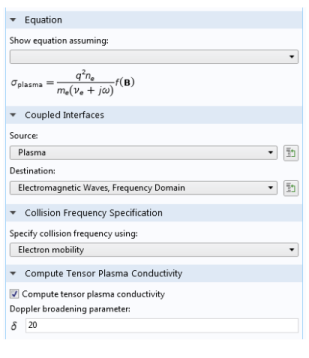where  is the electric field (V/m),
is the electric field (V/m),  is the magnetic flux density (T),
is the magnetic flux density (T),  is the magnetic field (A/m),
is the magnetic field (A/m),  is the plasma current density (A/m2
is the plasma current density (A/m2), and

is the electrical displacement (C/m
2). The tilde is used to denote that the field is varying in time with frequency
ω/2
π. The plasma current density can be approximated by this expression:
where q is the unit charge (C),
ne is the electron density (1/m
3), and

is the mean electron velocity under the following two assumptions:
where me is the electron mass (kg) and
νm is the momentum transfer frequency between the electrons and background gas (1/s). As pointed out in
Ref. 1, the equations are linear, so we can take a Fourier transform of the equation system. Taking a Fourier transform of equation
Equation 6-27 gives:
Equation 6-24 and
Equation 6-25 can be re-arranged by taking the time derivative of
Equation 6-25 and substituting in
Equation 6-24:
where μ is the permeability,
σ is given in equation
Equation 6-28 above, and the plasma relative permittivity set to one. The equation could also be recast where the relative permittivity is complex-valued and the plasma conductivity is zero
Ref. 3. The convention employed throughout the Plasma Module is that the plasma conductivity is given by equation
Equation 6-28 and the plasma relative permittivity is set to 1.
where J is the total current density (the plasma current plus the displacement current density) and
° denotes the complex conjugate.
In addition to the equation above, a set of equations are solved in the time domain for the electron density ne, electron energy density
nε, plasma potential
V, and all ionic and neutral species. These are the same equations solved in the Plasma interface and are given in the
Plasma Reactors Theory section.
where νe is the collision frequency between the electrons and neutrals.
where 
is the effective collision frequency to account for nonlocal effects. This is discussed in more detail in Ref 1, where an effective collision frequency of no more than
ω/20 is suggested.
When modeling ECR (electron cyclotron resonance) reactors, another layer of complication is added to the problem. The electron transport properties become tensors and functions of a static magnetic flux density, which can be created using permanent magnets. The plasma conductivity also becomes a full tensor, and a highly nonlinear function of the static magnetic flux density. In addition, it is necessary to consider all three components of the electromagnetic field. Comprehensive details on how to set up and solve a model of an ECR reactor can be found in the Dipolar Microwave Plasma Source model documentation.
The above equations are quite straightforward to solve, provided that the plasma frequency is below the angular frequency everywhere in the modeling domain. At a frequency of 2.45 GHz, this corresponds to an electron density of 7.6·1016 1/m
3, which is lower than most industrial applications. When the plasma density is equal to this value, the electromagnetic wave transitions from propagating waves to evanescent waves. Applications of microwave plasmas where the electron density is greater than the critical density include:
The Doppler broadening parameter,
δ, corresponds to the value used for the effective collision frequency via the formula:
Using this option results in a more stable equation system because the total power transferred to the electrons remains constant. When you use the Port input power option, some of the power is deposited and some is reflected back out of the port, depending on the plasma’s current state. The plasma can go from absorbing a very small amount to a very large amount of power in a very short time period, which can make the problem numerically unstable or lead to the solver taking extremely small time steps. This resonant power absorption mechanism also makes the use of the stationary solver very difficult to use and it is not recommended for such cases.
When the Specify deposited power option in the
Port boundary condition is used, the solver suggestion is modified so that there are three groups:
